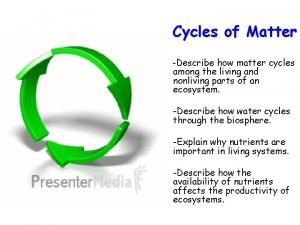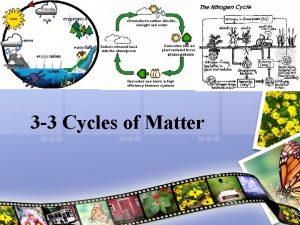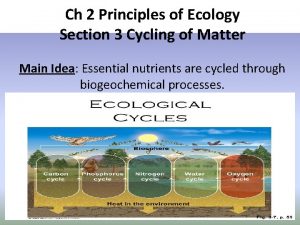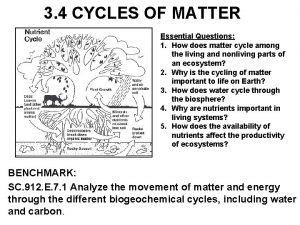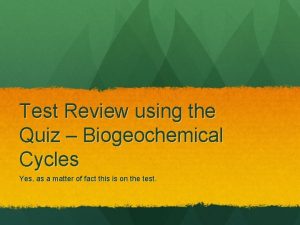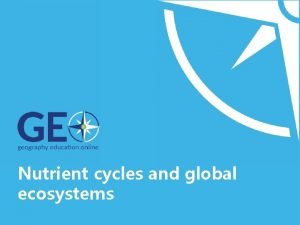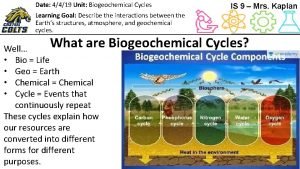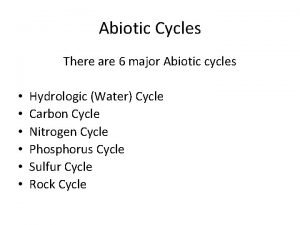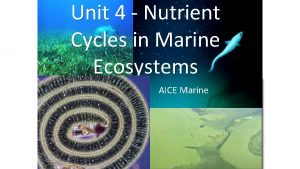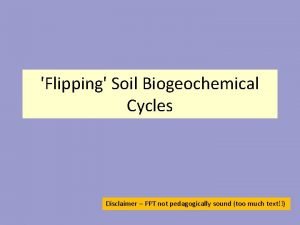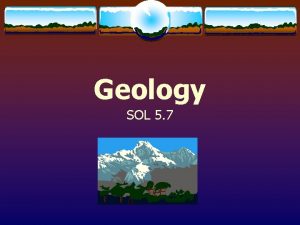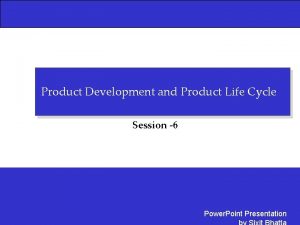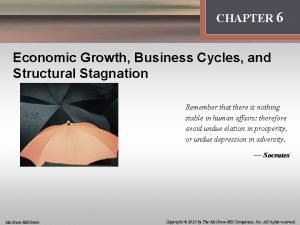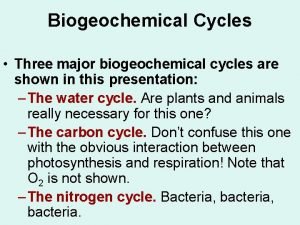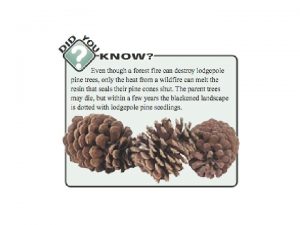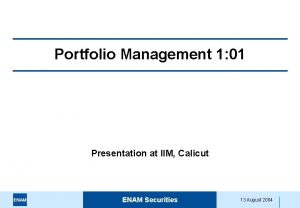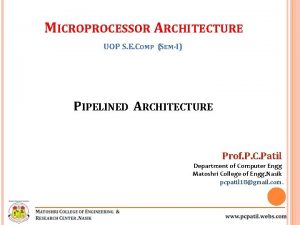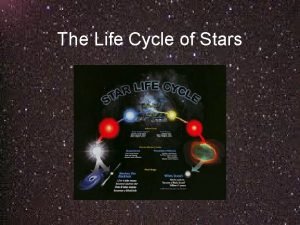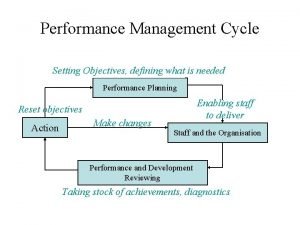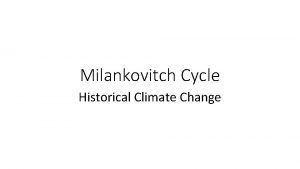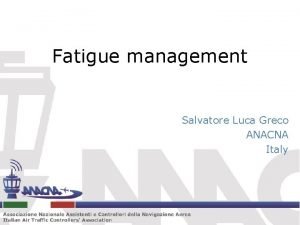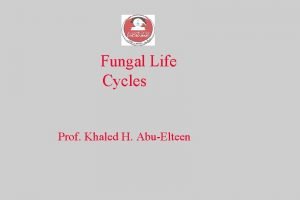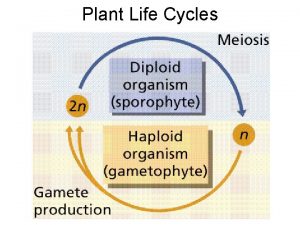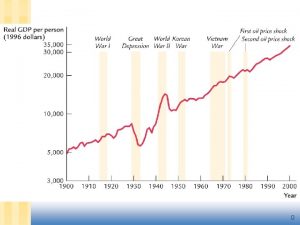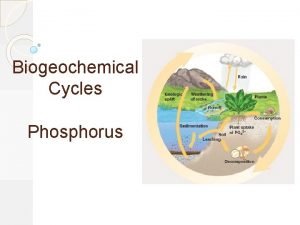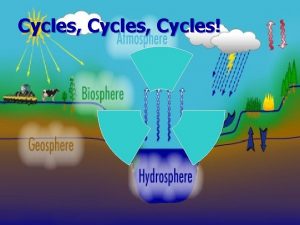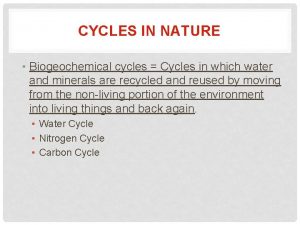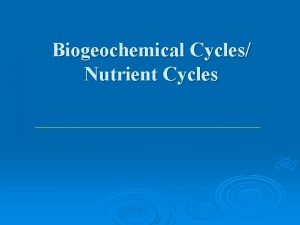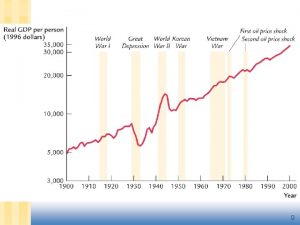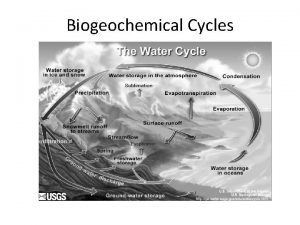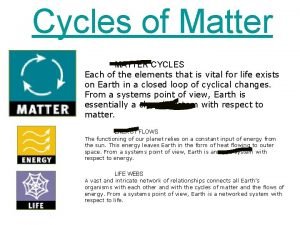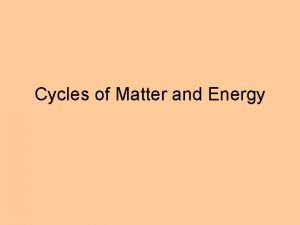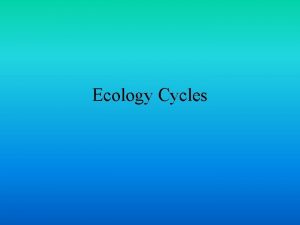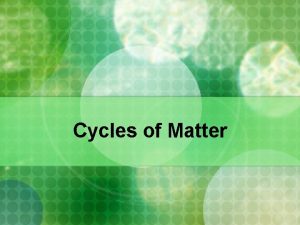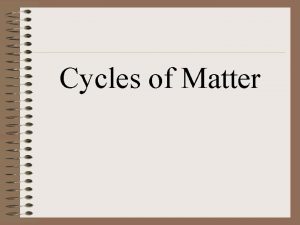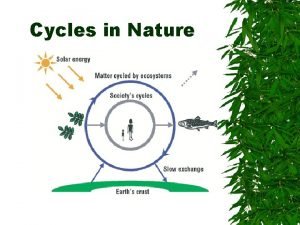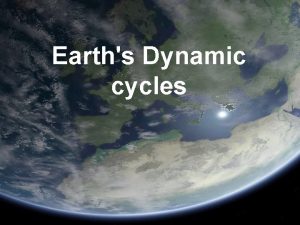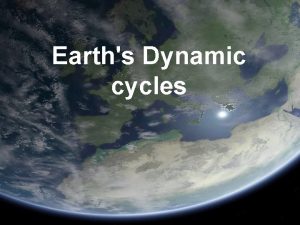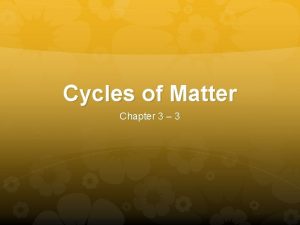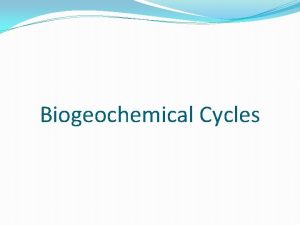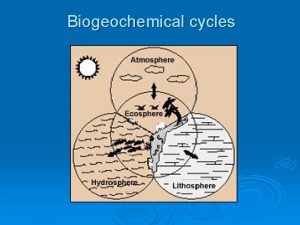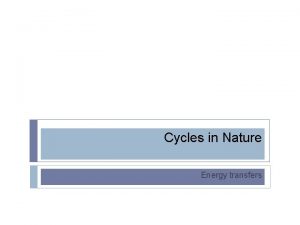Cycles of Matter What is matter Matter It

































- Slides: 33

Cycles of Matter

What is matter? Matter It is everything around you. can be a solid, liquid or a gas! LAW OF CONSERVATION OF MATTER Important concept: Matter cannot be created or destroyed! It can only change form. So what do you do with the matter? Cycle it between the biotic (living) world and the abiotic (non-living) world.

AC- Biogeochemical Cycles Biogeochemical cycles describe the flow of essential elements from the environment to living things and back to the environment. There are FOUR major cycles: 1. Water Cycle 2. Carbon Cycle 3. Nitrogen Cycle 4. Phosphorus Cycle There are major store locations (or reservoirs) for essential elements, the processes through which each element incorporates terrestrial plants and animals (assimilation), and the process through which each element returns to the environment (or release). In other words: Reservoirs are where you find it. Assimilation is how plants and animals get it. Release is how it returns to the environment.

Water Cycle

Water Cycle

AC Water Cycle Also known as the hydrologic cycle. Reservoirs: oceans, air as vapor, groundwater, glaciers. Evaporation, wind, and precipitation move water from oceans to land. Assimilation: plants absorb water from soil, animals drink water or eat other organisms(which are mostly water) Release: plants transpire, animals and plants decompose.

WATER CYCLE PYRAMID NOTES Evaporation – the change of state from liquid to gas Condensation – change of state from gas to a liquid Precipitation – any form of water that falls from the sky to the earth Transpiration – evaporation off plants. Change from liquid to gas Water cycle – The movement between oceans, atmosphere, land, and living things

Carbon Cycle

What is a carbon atom? #6 on the periodic table. It’s symbol is “C”. All living organisms are based on the carbon atom. Organic compounds contain carbon atoms bonded to hydrogen atoms. Inorganic does not. Carbon atoms continually move through living organisms, the oceans, the atmosphere, and the crust of the planet.


What are the basics of the carbon cycle? Plants use carbon dioxide, water, and sunlight to make sugar (glucose) molecules and oxygen. Animals take in oxygen and break down sugar molecules releasing energy, carbon dioxide, and water. Photosynthesis: Plants make FOOD from ENERGY Cellular Respiration: Organisms make ENERGY from FOOD.

Simple picture

A more complex picture

How do plants do it? Photosynthesis! The process by which producers use the energy from sunlight to produce glucose (sugar), which consumers convert to “fuel”. 6 H 2 O + 6 CO 2 + Energy -----> C 6 H 12 O 6+ 6 O 2 6 molecules of water + 6 molecules of carbon dioxide + sunlight = 1 molecule of sugar + 6 molecules of oxygen Photosynthesis occurs in chloroplasts of plants!

How do animals do it? Cellular Respiration! The process by which cells use the oxygen and sugar to produce energy from food (sugars). C 6 H 12 O 6+ 6 O 2 -----> 6 H 2 O + 6 CO 2 + energy 1 molecule of sugar + 6 molecules of oxygen = 6 molecules of water + 6 molecules of carbon dioxide + ATP (chemical energy) Cellular Respiration occurs in the mitochondria of cells.

Human Impact Humans also add to the Carbon Cycle! For 800 years before the Industrial Revolution the global CO 2 levels were fairly consistent. Over the past 200 years there has been measureable change in levels. Human activity is largely responsible for this. Burning of fossil fuels and deforestation are the primary causal factors. Consequence: increase in CO 2 levels result in higher global temperature. The rate is prohibitive to the dispersal of plants and animals to regions in which they can survive. Polar summer ice is in jeopardy, and sea level rise is imminent as well. Combustion- burning of fossil fuels. Combustion of organic matter releases carbon dioxide into the atmosphere.

AC- Carbon Cycle Summary Carbon is cycled (converted) from Inorganic Carbon (CO 2) is to Organic Carbon (C₆H₁₂O₆)…and the other way around. CO₂…it’s inorganic even though it has carbon. Technically organic compounds have to have carbon bonded to hydrogen (hydrocarbon). Reservoirs: atmosphere as CO₂, fossil fuels (coal and oil), peat, durable organic material (for example, cellulose found in cell walls of plants to make them strong). Assimilation: plants use CO₂ in photosynthesis and animals consume plants and other animals. Release: plants and animals release CO₂ through respiration and decomposition. CO₂ is released through combustion.

CARBON CYCLE PYRAMID NOTES Photosynthesis – plants make food from energy 6 H 2 O + 6 CO 2 + Energy -----> C 6 H 12 O 6+ 6 O 2 Cellular Respiration –organisms make energy from food C 6 H 12 O 6+ 6 O 2 -----> 6 H 2 O + 6 CO 2 + ATP (ATP is energy) *Autotrophs breathe in CO 2 and produce O 2 *Heterotrophs breathe in O 2 and exhale CO 2 Combustion – process of burning fossil fuels Decomposition – breakdown of substances into molecules

Nitrogen Cycle

Nitrogen Atoms All life requires nitrogen: -protein synthesis and DNA are just a few uses by animals -plants need it for chlorophyll which is needed for photosynthesis Air is 78% nitrogen gas (N 2). Most organisms cannot get it directly from the atmosphere. Nitrogen by itself in the atmosphere is called FREE nitrogen. Nitrogen that is attached to other elements is called FIXED nitrogen…that’s the kind we need.

Nitrogen Cycling Basics Most organisms cannot use nitrogen in the form N 2 or “Free Nitrogen”. It must be combined with other molecules or “Fixed”. This is done by bacteria who live in “nodules” on plant roots. (nitrogen fixation) This is an example of mutualism! Lightning also fixes Nitrogen.

Simple Picture


Nitrogen Cycle Summary 1. Free N₂ in the air can’t be used by most organisms. 2. Nitrogen Fixation-Bacteria in soil and water chemically change N₂ into usable Nitrogen compounds. 3. Plants then take and use the fixed nitrogen. Animals consume the plants. 4. Decay-organisms die and decompose returning nitrogen back to the atmosphere.

Human Impact Burning of fossil fuels and use of nitrogen-based fertilizers alter the amount of bio-available nitrogen (this is HUGE limiting factor for ecosystems). Terrestrial ecosystems: Extra nitrogen can lead to nutrient imbalance in trees, changes in forest health, and declines in biodiversity. Since more nitrogen is available, carbon storage is affected. There’s more than just the nitrogen cycle getting messed up. With factory farming, fertilizers are spread to increase crop yield, but the unused nitrogen (nitrate mostly), can leach out of the soil into the streams and rivers. This ends up in our drinking water. Marine Ecosystems…too much nitrogen = depleted O 2 and toxic dinoflagellate blooms (RED TIDE).

AC-Nitrogen Cycle Nitrogen is required for the manufacture of all amino acids and nucleic acids (DNA is a nucleic acid. It’s name is actual name is Deoxyribonucleic acid ) Reservoirs: atmosphere as (N₂), soil (NH₄+ ammonium, NH₃ ammonia, NO 2 nitrite or NO 3 - nitrate) Assimilation: plants absorb nitrogen as either NO 3 - or as NH₄+ , animals obtain nitrogen by eating plants or other animal. Nitrogen fixation: N₂ to NH₄+ by nitrogen fixing bacteria in soil and root nodules or N₂ to NO 3 - by lightning Nitrification: NH₄+ to NO 2 - and NO 2 - to NO 3 - by bacteria Release: bacteria convert NO 3 - back to N₂ through decomposition (denitrification); other bacteria convert organic compounds back to NH₄+ through decomposition (ammonification)

NITROGEN CYCLE PYRAMID NOTES Free nitrogen in the atmosphere as N₂ (78%) – we cannot use this form; needed to build proteins, DNA, and amino acids Animals obtain nitrogen by eating other organisms Nitrogen fixation – lightning or bacteria in the soil converts it to a usable compound Decay – organisms die, decomposers break them down is releasing nitrogen into the air Denitrification – bacteria converts waste back to free N₂.

PHOSPHORUS CYCLE ***AC only!!!!!***

Phosphorus is an important element that is a key part of ATP, nucleic acid molecules the phospholipid membranes in cells, bone, shells, etc. ATP’s actual name is Adenosine Triphosphate Unlike the nitrogen, water, and carbon cycles, phosphorus is mostly found in the Earth’s soil and rocks in compounds called phosphates (PO 43 -).


Phosphorus Cycle Most Phosphorus is stored in the crust as the mineral Apatite or calcium phosphate Ca₅(PO₄)₃ Granite is where you can find apatite, but it is also found in metamorphic and sedimentary rocks too. Some phosphorus is dissolved in fresh and ocean water, or is stored in soil or in organic matter. Plants can take phosphates from the soil like they do with nitrogen, but no special bacteria for this one.

Human Impact When fields are overfertilized (through commercial fertilizers or manure), phosphate not utilized by plants can be lost from the soil through leaching and runoff. This phosphate ends up in waterways, lakes and estuaries. Excess phosphate causes excessive growth of plants in waterways, lakes and estuaries leading to eutrophication. Runoff from mining and from fertilizer use leads to buildup of phosphorus. Too much phosphate (or nitrogen) isn’t a good thing and can lead to problems such as lake eutrophication (nutrient buildup) leading to algal and bacterial blooms. These producers use up the oxygen fish and other aquatic animals die.

Phosphorus Cycle Summary Phosphorus is required for the manufacture of ATP and all nucleic acids. Reservoirs: rocks and ocean sediments. Erosion transfers phosphorus to water and soil; sediments and rocks that accumulate on ocean floors return to the surface as a result of uplifting geological processes. Assimilation: plants absorb inorganic PO 43 - (phosphate) from soils, animals obtain when they consume plants and other animals. Release: plants and animals release phosphorus when they decompose. Animals also release through their waste products.
 Water cycles of matter
Water cycles of matter 3-3 cycles of matter
3-3 cycles of matter Lesson 2 cycles of matter answer key
Lesson 2 cycles of matter answer key Precipitation in the water cycle
Precipitation in the water cycle Biogeochemical cycle quiz
Biogeochemical cycle quiz Nature recycling system
Nature recycling system Milankovitch cycle
Milankovitch cycle Biogeochemical cycles
Biogeochemical cycles The major abiotic reservoir for phosphorus is
The major abiotic reservoir for phosphorus is Mandarin cycles
Mandarin cycles Alphonse mucha advertisements
Alphonse mucha advertisements Model for improvement
Model for improvement Nutrient cycles in marine ecosystems
Nutrient cycles in marine ecosystems Biogeochemical cycles class 9 ppt
Biogeochemical cycles class 9 ppt Solid rock cycles
Solid rock cycles Style fashion and fad life cycles
Style fashion and fad life cycles How to calculate real gdp per capita
How to calculate real gdp per capita Cpi cycles per instruction
Cpi cycles per instruction 4 major biogeochemical cycles
4 major biogeochemical cycles Compare and contrast carbon and nitrogen cycles
Compare and contrast carbon and nitrogen cycles Mandarin cycles
Mandarin cycles Practice geochemical cycles answer key
Practice geochemical cycles answer key Enam securities portfolio
Enam securities portfolio ……………types of bus cycles / operations in 80386dx
……………types of bus cycles / operations in 80386dx Modern database design
Modern database design Life cycles of stars
Life cycles of stars Tsw cycles
Tsw cycles Per instruction
Per instruction Explain the performance management cycle
Explain the performance management cycle Precession milankovitch cycles
Precession milankovitch cycles Business cycles occur in free enterprise systems because
Business cycles occur in free enterprise systems because Sleep wake cycles
Sleep wake cycles Sac fungi life cycle
Sac fungi life cycle Plant life cycles and alternation of generations
Plant life cycles and alternation of generations
